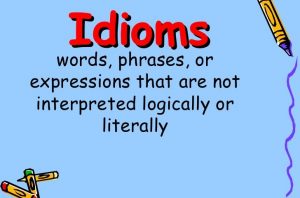Translating idioms is a very difficult task for a translator especially if he is not aware of the cultural differences between the source and target languages. Idioms can be considered as a part of everyday language and not all have direct equivalents in another language because they are specific to a single culture.
They characterize by:
– consisting of more than one word, and is usually an expression or a phrasal verb
– The meaning of an idiom is not deducible from the meaning of individual words.
– The word order and the grammatical structure of an idiom cannot be changed
– Any of the words forming an idiom can neither be omitted nor replaced by other words
According to Newmark (1988): “in translating idiomatic into idiomatic language, it is particularly difficult to match equivalence of meaning with an equivalence of frequency” (p. 28). He believes that the main problems, a translator faces, are not grammatical but lexical, i.e. words, collocations, and fixed phrases or idioms (Newmark, 1988). If they are to be translated literally or word for word, they lead to extreme confusion.

The following have been identified as the many challenges a translator has to face when translating idioms:
– Recognition
– No equivalent in the target language
– A similar counterpart in the target language with a different context of use
– An idiom used in the source text both in its literal and idiomatic sense at the same time
– The difference between the convention, context, and frequency of use in the source and target languages (2004, p. 193).
To understand idioms better, they have been classified as:
COLLOQUIALISM: used in daily conversations, only appropriate for casual, ordinary, familiar or informal conversation rather than formal speech or writing.
PROVERBS: often have an equivalent in the target language. However, even if a linguistic equivalent exists, there may be cultural differences to consider.
SLANG: its usage is increasingly common for being an informal nonstandard vocabulary composed typically of coinages, arbitrarily changed words, and extravagant, forced, or facetious figures of speech
ALLUSIONS: is a figure of speech that makes a reference to a place, person, or something that happened. This can be real or imaginary and may refer to anything, including paintings, opera, folklore, mythical figures, or religious manuscripts. The reference can be direct or may be inferred, and can broaden the reader’s understanding.
PHRASAL VERBS: is the combination of a verb and a preposition, a verb and an adverb, or a verb with both an adverb and a preposition. A phrasal verb often has a meaning which is different from the original verb.
In order to be able to translate these idioms, it is the translator’s job to extract the figurative meaning of the idiom and to find a parallel expression in the target language.
The difficulty arises from the fact that words of an idiom should not be translated literally; ” these (idioms) are never translated word for word’’ (Newmark, 1988: 125). It has also been emphasized by Larson (1984:20), that:’’ The real danger comes in translating an idiom literally since the result will usually be nonsense in the receptor language’’.
Words of an idiom, therefore, are not to be translated in isolation; rather the translator should go after the real meaning or image transferred by each idiom. Three different techniques are suggested to help translators to produce the most effective endeavor.
- TOTAL EQUIVALENCE: Form + Meaning
According to Baker (1992:72),” this strategy of finding an idiom of similar meaning and similar form in the target language may seem to offer the ideal solution, but that is not necessarily always the case”.
- PARTIAL EQUIVALENCE: Similarity in meaning not in form. This strategy involves translating a source idiomatic expression into its equivalent target idiom which conveys the same meaning but has a different form
- PARAPHRASING: involves giving a brief explanation of the meaning behind the idiomatic expression being used
In order to better translate an idiom, the translator should identify it from those expressions which are not idioms. Once properly identified, idioms can be transferred like any other abstract lexical unit. Speaking foreign languages obviously requires a knowledge of grammar as well as a wide range of vocabulary. However, it is essential not to forget the cultural background of the countries where the languages are spoken. As Vermeer, well said, a translator needs to be not only bilingual or multilingual, but also must be bicultural or multicultural. Remember! While translating idioms it is better that you do some research for the meaning of a source language idiom on the Internet or in the vocabulary and find an appropriate solution for the target language.

